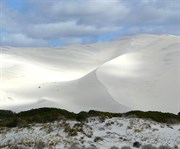Travel and explore AUSTRALIA and all it has to offer. Whether you go camping, RV'ing, Hotel or Motel accommodation style, or your own caravan. National Parks have so much to offer.
National parks are only one of many types of reserves dedicated for nature conservation in Australia. The others include nature reserves, historic sites, Aboriginal sites, game reserves and scientific areas.
Altogether there are more than 3200 nature conservation areas in Australia, including 665 or more national, conservation and other parks, which occupy nearly 410 000sq km. or just over 5 per cent of the continent's land area. In addition there are more than 220 protected offshore areas, such as marine parks, aquatic reserves, fish sanctuaries and historic shipwrecks. These aquatic areas occupy approximately 384 000 sq km. Beyond Australia's coastal waters there are two other national parks, Christmas Island National Park and Norfolk Island National Park, as well as national nature reserves that protect reefs and cays to the north and east of the continent. Two of these nature reserves, Coringa Herald National Nature Reserve and Lihou Reef, have a combined area of approximately 17 300 sq km.
National parks are set up and managed by the states and territories, each of which has its own definition of exactly what constitutes a national park. Generally the term is used for large areas of outstanding interest or beauty that have been set aside for protection, education and public enjoyment. Some states have a number of categories for parks. South Australia, for example, distinguishes between national parks and conservation parks, the latter being less developed and receiving fewer visitors. Only two mainland parks are administered by the Australian National Parks and Wildlife Service, namely Uluru and Kakadu, both in the Northern Territory.
National parks are only one of many types of reserves dedicated for nature conservation in Australia. The others include nature reserves, historic sites, Aboriginal sites, game reserves and scientific areas.
Altogether there are more than 3200 nature conservation areas in Australia, including 665 or more national, conservation and other parks, which occupy nearly 410 000sq km. or just over 5 per cent of the continent's land area. In addition there are more than 220 protected offshore areas, such as marine parks, aquatic reserves, fish sanctuaries and historic shipwrecks. These aquatic areas occupy approximately 384 000 sq km. Beyond Australia's coastal waters there are two other national parks, Christmas Island National Park and Norfolk Island National Park, as well as national nature reserves that protect reefs and cays to the north and east of the continent. Two of these nature reserves, Coringa Herald National Nature Reserve and Lihou Reef, have a combined area of approximately 17 300 sq km.
National parks are set up and managed by the states and territories, each of which has its own definition of exactly what constitutes a national park. Generally the term is used for large areas of outstanding interest or beauty that have been set aside for protection, education and public enjoyment. Some states have a number of categories for parks. South Australia, for example, distinguishes between national parks and conservation parks, the latter being less developed and receiving fewer visitors. Only two mainland parks are administered by the Australian National Parks and Wildlife Service, namely Uluru and Kakadu, both in the Northern Territory.

